lorrywaydown
Vince & Jac's little get away

Arctic Circle, and travel costs in Norway.
Ok, a couple of things you need to know about Norway, and more specifically travelling through Norway in a camper van, 1) its big and 2) its expensive; But there’s more to it than that…….
First lets look at the size of Norway and the implications of motor homing here, whilst in terms of land mass its not that huge only ranking 67th in the world (by comparison the UK is 78th, so not a massive amount of difference), but because of the shape of Norway it actually has the second longest coast line in the world, after Canada (UK is 12th, while even Australia is in a lowly 7th in the world). The reason for this vast coastline is the number and size of the fjords (and of course the islands). This brings me to why this effects travelling on 4 wheels. It can be a very long way between A to B on the map, 100km in a direct line could easily equal driving 300km on the road, especially if you want to avoid the cost of a ferry or you want to take in a “scenic route”. I’ve calculated that the average cost of a ferry across a fjord allows us to drive about 200-250km (in terms of diesel), so where practical we do drive. Having said that we have so far used 8 ferries (including a tunnel with a pay booth), so you can see its not really practical to think you can travel up the coast of Norway without using some ferries, especially as we don’t really have too many time restraints.
I’ll come back to the costs in a bit, but first I must tell you that Norway is a truly magnificent country to tour, especially in a motorhome. We have both been lucky enough to travel to many parts of the world, and we both agree there is nowhere that either of us have been, that can match the sheer scale and beauty of Norway and especially the coast, fjords and mountains! It really is relentless. Every turn of the corner, every exit from a tunnel, every brow of a hill brings a new “gob smacking” vista. We’ve seen Moose, Reindeer, Golden Eagles, White-Tailed Eagles, Seals, Porpoises, we’ve caught Cod (aplenty), and even Brown Trout. The place is a real wilderness paradise.





We have done quite a bit of hiking, most start at the lowest point and go up, sometimes very steeply, but usually the trails are well marked, and easy to follow. The only issue we have is that as its still quite early in the season and at higher altitudes there can still be deep snow, and it can be impossible (and would be quite stupid) to carry on and follow the trails up.
For us travelling in Sweden and Norway at this time of year has more advantages than disadvantages, there just aren’t the number of tourists (especially in motorhomes) that would be here in say July and August. Obviously most attractions, cafe’s, restaurants, museums etc are still closed, but thats fine for us in our little motorhome, Zorro.


Obviously its cold, and yes it can get very cold at night, deep in the minus side of the thermometer, but mostly its sunny, and we have only had one day where it rained all day. Our Hymer 4×4 Sprinter has been brilliant so far, being well insulated and the heating system has kept us cosy warm and protected the water systems from freezing at night. It has also got us into some fantastic wild camping spots, that had we been driving a standard front wheel drive motorhome we wouldn’t have even attempted.
We have so far wild camped 29 nights (cost free obviously) out of 32 nights in Norway, this not only reduces our living costs massively but makes for a much richer experience. We wild camp in Norway though choice not financial necessity, it difficult to describe how cool most of these places are to camp in, and we are learning more and more the best way to seek out these places.


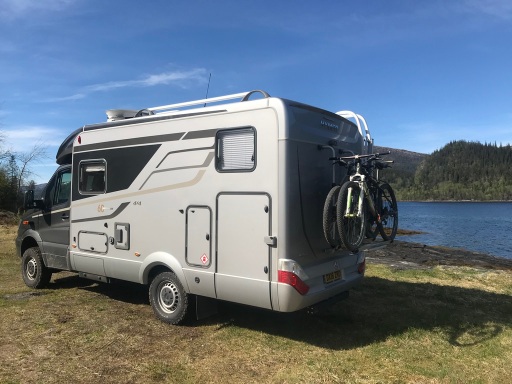


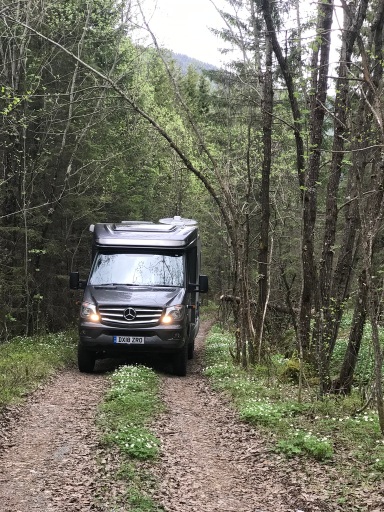

A week or so ago we crossed the Arctic Circle, a major goal for us on this trip, The amount of snow still on the ground was surprising, until we saw on our satnav the altitude that we were at, nearly 2,000 feet above sea level and at the Arctic Circle!




We are currently on the Lofoten Islands and another example of the size of Norway, this small archipelago of islands takes 350km (220 miles) to drive from the far north (Andenes) to the far southwestern village of A (yes thats what its called), and its a tight, windy and hilly main road, this distance doesn’t include all the interesting smaller roads that we take. So getting anywhere takes time, a lot of time……



The Lofoten Islands are indeed stunningly beautiful with many sandy beaches, lots of walking trails, fjords galore, and high mountains, but it really is a magnet for tourists. During our time driving north we have seen hardly any motorhomes (apart from Norwegians), but here on the Lofotens we’ve suddenly had an overload of other tourists, in both motorhomes and rental cars, and I would guess probably 80% are Germans, its a real shock to the system. To put this into context its not the Isle of Skye in the summer, or southern Spain in winter, but there are a lot of tourists here, I can’t imagine what it would be like in the high season with these small roads.
This brings me back to costs. Apart from motor homing, my other passion is motorbike touring and if you had to pay for a room every night and eat out a couple of times a day, as you do on a bike trip the costs would literally be prohibitive. We don’t eat out at all generally, preferring to use our limited cash for diesel to travel more, but we have seen some incredible prices for food while we’ve had a cappuccino (our one financial vice). How does over £20 for a plain burger grab you, or £14 for a bowl of fish soup, and pizza’s seem popular here (as everywhere) but at over £20 each???
So what about Motorhoming specific costs in Norway? Well diesel is slightly more than the UK, a campsite (if you feel the need) is anything from £20 to £35 for a night, plus electric hook up at £5, and quite often showers are extra at £2 for 3 minutes. This would obviously add up dramatically if you used them a lot. We aim to use a campsite once every couple of weeks purely as a way to do the laundry. A washing machine is from £5 to £10 a time, and the same again for the dryer. Two washes and two driers costs anything from £20 to £40 and the competition for these can be fierce, as many camp sites only have one washing machine and one drier. We have learnt that if we do use a campsite we get there by lunchtime and hopefully we are the first to use them, theres usually a queue behind us!
Other costs are ferries, road tolls, and of course groceries. I discussed ferries earlier and road tolls are mainly on the main routes, so many of these can be avoided by using smaller roads. We pre-registered with Autopass for the tolls while back in the UK, and we are trying to keep a track of the amounts as we go through each section (it indicates the amount), but it can take up to 3 months for the amounts to be taken from your bank account.
In Norway they have a system where once a new section of road or a tunnel or bridge is opened a toll is charged until the section is paid for, so the road tolls are always changing. For example we were driving one day, following our map and sat nav and had seen that we had to drive all the way around a fairly small fjord, when we unexpectedly passed a very smart new bridge that went right over the mouth of the fjord, a quick U turn, and we drove over this fine piece of engineering. It was only when we got to the far side that the signs appeared that it was indeed a toll road. That bridge cost us £25.00 (by far our most expensive road toll to date), an expensive U turn.
Ok now groceries, I would guess that an average spend here for a quick shop for mostly fruit and vegetables, and a few other bits costs about £70.00, I would estimate that those same items bought in Aldi or Lidl would cost less than £30.00, so considerably more here in Norway. To put it into context we drove back to Sweden for one night (to the ski town of Are) purely to stock up with food and booze, Sweden was expensive but Norway is truly on another level of expense.
There are some strange prices here compared to the UK too. Why is Strawberry yogurt 30% less than all other flavours (inc plain), same make and size, and why are Paprika flavoured Pringles always cheaper than plain or other flavours? Its always the same in all shops/supermarkets. And sugarfree soft drinks are more expensive (usually) than those with sugar, like Coke or Pepsi. We are very careful about buying the cheapest brands and not buying anything crazily expensive, so watch the prices of what items we pick up. One day after a supermarket shop, I was looking at the till receipt, and to my shock the most expensive item (the one item that we didn’t check the price of) was a loaf of bread, it was over £4.00 for a standard uncut loaf!!!!!.
Below are our costs for the last month, being in Norway apart from a night in a campsite in Sweden to do laundry and a big shop for food and drink (I have also included this).
Fuel inc adblue £659.42
Food and drink Shopping £572.74
Eating and drink out £142.66
Ferries and tolls (not road tolls) £260.24
Road tolls approx £100.17
Camping inc laundry £124.47
Gas, refilling bottles £34.00
Total for 32 nights £1,893.70.
This works out at just over £59.00 per night, but you must remember we have not camped in one place for more than one night, and so we are driving lots of kilometre. We also brought with us a huge amount of supplies (this has kept our shopping bill down considerably). Obviously this amount would increase greatly if we were to use campsites more often.



The other thing about being this far north at this time of year (we are above the 68th parallel North, this is the same latitude as northern Alaska), is it just doesn’t get dark. the sun apparently is currently setting after midnight and rising before 1.00am. This basically means it really doesn’t get dark, not even twilight. This can lead to weird sleeping patterns, personally I struggle to actually want to go to bed. Even with all the black out blinds closed you still know its bright sunlight at two in the morning. It will really take some getting used to, the summer solstice is not for another month yet.
The photo below was taken a couple of days ago at just before midnight, it doesn’t look like its setting any time soon eh? On a plus side theres nothing to stop you setting off for a two hour walk at eleven o’clock at night…….

Another example of how light it is, came last night, Jac had gone to bed and I was busy googling stuff. We were wild camped on the coast with massive steep mountains behind us. At just after midnight I heard a really loud noise from outside that was getting louder and louder, at first I thought it was farm machinery coming up the road, then it dawned on me it was a rock coming down the mountainside towards us. I shouted to Jac and lept out through Zorro’s door, I still couldn’t see it but it was getting louder and closer, then from under the low cloud (remember its clear daylight even at this time), appeared a boulder the size of a mini bus smashing its way down the near vertical hill side. Every time it hit the mountain it smashed more pieces of rock away, my adrenaline was pumping big time!!!! I then realised that it was thankfully going to end up over to the left of us, and settled harmlessly at the base just before the road. Phew that was close and a real wake up call. If it wasn’t light it would have been truly terrifying just listening to this hulk of rock hurtling towards you and being unable to do anything, thankfully it was broad daylight.
Thanks for reading, next stop Nordkapp (hopefully)
Vince
Sweden to the Western Fjords
When I last wrote in this blog we were on a small island in Siljan Lake in central Sweden, one thing that surprised me was the fairly low water level of the lake, you could easily see the high water line, and at the time it was well below these levels. This was Spring time, at the end of April and it was now warm and sunny, I could only imagine that the main precipitation falls in either rain or snow in the winter. So why was the lake still so low? Is this another indicator of climate change, or am I missing something?
From Siljan we headed northwest and suddenly the answer to the above question was clear. We found an amazing wild camp on the side of a lake, and not only was there still quite a bit of snow about but unlike all the dozens of lakes that we had previously seen, this one was still frozen.


We were now at a far higher altitude, and obviously all this water still has to find its way down to the lower lakes.
It was still really warm in the sunshine (I was still wearing shorts), but at night the temperature really plummeted and all the melted ice on the margins of the lakes refroze overnight, my guess would be roughly -5c. The motorhome was fantastic in these conditions, with the heating working with the well insulated walls, floor and roof to keep us really toasty warm. This was a really special place to spend the night, all on our own, not another soul around.
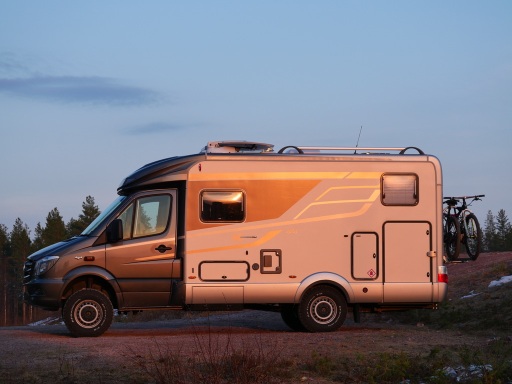
The next day we continued northeast and visited Fulufjallets National Park, this huge area straddles the Swedish and Norwegian border (though there’s no road running through here). We had heard that there is some excellent hiking, so thought maybe we might spend a couple of days here. Mmmmmm the only problem was we were even higher and so there was a lot more snow and ice about.

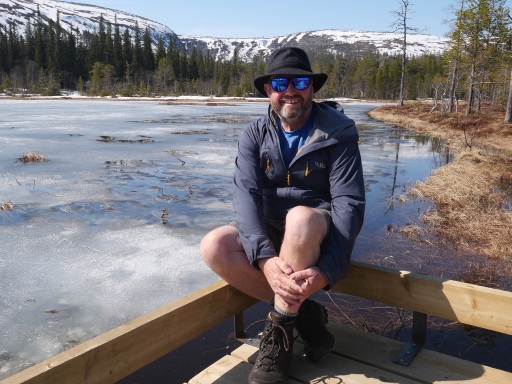

The main reason that people visit Fulufjallets is to see the waterfall, (I think its the highest in Sweden), so that was definitely on the hiking list. We decided to go to the reception building to see where else we could walk to. In true Swedish style the building was magnificent, with lots of exhibits and although it was a Saturday it was very quiet with very few vehicles in the carpark. They obviously weren’t expecting too many guests either as 90% of the car parking area was still covered in deep snow. Asking the ranger working in the reception building about possible hikes drew some strange looks, “the snow is rotten at the moment, and so all the trails are closed apart from to the waterfall, stay on the marked trail!” She then noticed I had shorts on and I’m sure she thought ‘stupid idiot’!
A few meters into our hike to the waterfall, I found out why you stay on the trails in “rotten snow” conditions……….

The waterfall (partly frozen) was really stunning, especially in the backdrop of the surrounding snow covered hills. The walk up to the waterfall was quite treacherous on the ice and snow, but it was a lot worse coming back down without slipping over every few seconds.




We spent another night wild camping next to a frozen lake, next to a very strange newly built church.





After we had dinner we decided to go for a walk along the lake shore and were surprised to find an old wooden footbridge over to a small island. We were even more surprised to find that this was an old cemetery.

Some of the memorials were a couple of hundred years old and some were only 20 or 30 years old, it was a very poignant place, especially on a cold still evening.

Further along the shore we even stumbled across a couple of cabins deep in the forest and next to the lake, a fantastic setting, but a hell of a bugger to get your shopping to!!


Next up for us was to head west towards Norway to start the trip up the coast to the Arctic Circle, the drive over the mountains was epic, the scenery was stunning, and at the very top of the mountain pass the snow at the sides of the roads was higher than our trusty Sprinter, Zorro (over 3 metres).
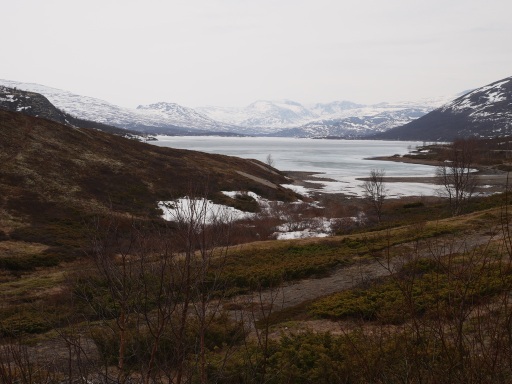
Our first overnight stop in Norway was Lillehammer, this was home to the winter Olympics of 1994 and was the year that the plucky brit Eddie the Eagle rose to fame in the crazy sport of ski jumping. We managed to park for the night right at the base of the ski jumping hill, and we were surprised to find the entire complex open for you to wander around, you can even climb the 870 steps to the top of the “launch site” for the fearless skiers. Of course we did this, and its a long long climb to the top.
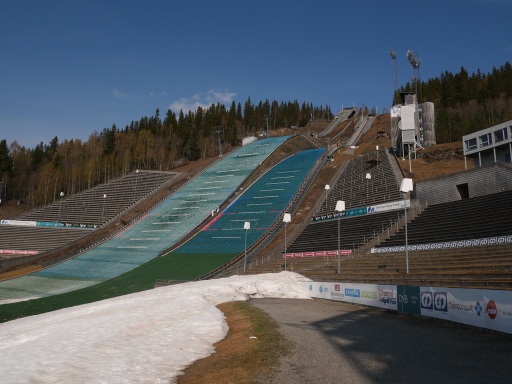

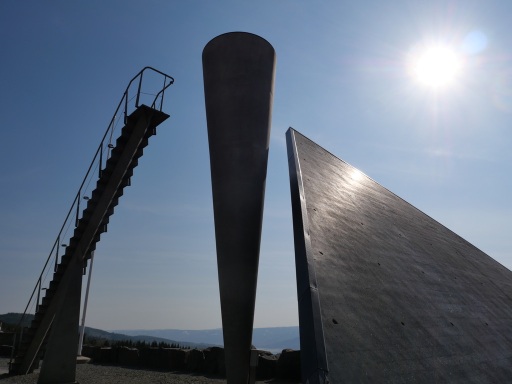
I just can’t imagine anywhere like this being open to the public and free of charge in the UK. The locals use the arena, especially the 870 steps as a fitness area, we saw a few people timing their climb to the top and back down, many also run up to the arena first from the town, this is also a very long way down. We visited Lillehammer town centre the next day and it is a very nice town with lots of high end shops, outdoor clothing and boutiques, a typical expensive ski resort really (though there’s not much downhill skiing done from here).
We then had to make a decision, our original plan was to visit Oslo to see a lovely Norwegian couple that we met in Namibia. but as we had travelled further north in Sweden than we planned, we decided to forgo the far southern part of Norway. So we drove directly east and hit the western fjords just north of Bergen at the far eastern end of the famous Sognefjorden. Wow, this place is truly beautiful, every corner you turn, there is more and more stunning scenery, water, mountains, forests etc etc.




We have zigzagged our way “up” the coast following the fjords along their southern coasts then back towards the sea along their northern coasts, occasionally doing the odd mountain pass (if it is open, as some are still closed due to snow).


This is very early in the season for Norway, the plus side of this is the lack of other tourists, I can imagine that some of these smaller roads in the summer must be a bit of a pain with the huge number of vehicles driving on them. It does mean that we can camp virtually anywhere at the moment, two weeks straight of amazing wild camping without using a campsite, its pure bliss. There are regular motorhome service points, with drinking water, waste water disposal and of course toilet waste disposal. Many of these are free of charge, the rest which do charge, are usually in a fuel station, so we usually use these to fill up with diesel and then you can use their facilities for free.
The other downside of travelling in this area of Norway in April and May is that most places this far north don’t open until June at the earliest, this includes cafes, restaurants, and museums but with the crazy prices here that really isn’t a problem for us anyway.
Tunnels…….. Norway really does do tunnels very well. They are everywhere, one day we drove through 16 tunnels, the next day 11 tunnels and trust me there are some epic tunnels, many are 6 or 7 km long (4 to 5 miles). Some even have an overtaking lane (that swaps direction half way through) but the best one so far, actually had a roundabout halfway through the tunnel, where another road intersected the one that we were on. The cost of all this infrastructure must have been immense but, they are still building more new tunnels, sometimes to replace ferry services, or even to put in a bigger new tunnel alongside the existing one (then the old one gets used solely for pedestrians and cyclists). Most of these are free to travel on but if its a new tunnel then there can be a charge until its paid for, then it will become free.
Then there are the ferries, again there are hundreds of ferry services crossing the Fjords. For us time isn’t too much of an issue, so many times we have driven around a fjord rather than pay for a ferry crossing, its also because the journeys are so stunning by road anyway. But sometimes you have to use a ferry as the other option just isn’t viable. Some of these fjords reach inland over 200km (120miles), so you could end up driving an additional 300-400km just to avoid a ferry. So far we have used 5 ferries and they range from £20.00 to £45.00 per “voyage” depending on how far the crossing is.

One day we drove to the far end of a fjord (Innvikfjorden) and then followed a small road weaving between small lakes until we could drive no further. At the end after a further 45 minute walk up hill, we reached the tip of Briksdal glacier, another breathtaking place.
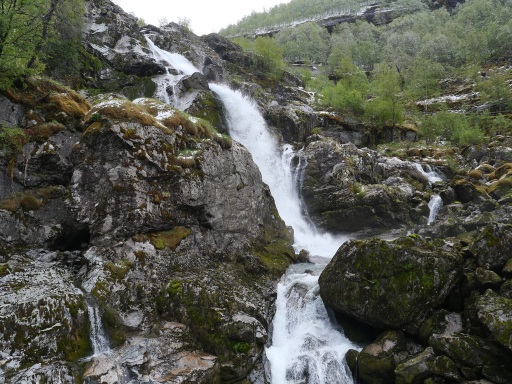


Then on the way down it started snowing big time. The weather here can be unpredictable and needs to be respected, at least I was back in long trousers……..

Back to tunnels….. We have entered a tunnel with 13c showing then half way through the tunnel its showing 0c before returning to roughly 13c again as you leave. We have also entered one of these subterranean worlds in bright sunlight and emerged in a blizzard. Then there’s the altitude change in the tunnel. We’ve entered a tunnel at sea level from a fjord only to drive up hill for 8 km and to emerge high up in the mountains!!! We drove one that actually goes deep under the seabed, starts on a small island, is 8km long, steep down hill (820ft below sea level) then steep uphill only to emerge into the town centre of Kristiansund. Why? probably because they can and more importantly they can afford to do it.
And then there are the bridges, wow they can build a bridge too. They have even built a bridge designed so that you can fish from it! I promise you this it is not a walkway or a cycle lane, this is a fishing platform!

As you can see the road is hardly busy, but what a backdrop, the tide was ripping through at such a pace that it was almost impossible to get my string of lures down.

Next time I will talk a bit more about the cost of Scandinavian travel in a motorhome and more specifically Norway, but in the meantime thanks for reading and I just want to introduce you to a couple of new friends that we’ve made, can you spot the odd one out?

Cheers Vince
Southern and Central Sweden, a wild camping heaven.
After crossing the mightily impressive (and crazy expensive) Oresund Bridge that links Denmark to Sweden, we decided to head South to the tiny peninsular that juts out back towards Denmark called Falsterbo. I’m pretty sure most tourists would go the other way and head to the city of Malmo, but as mentioned previously, we are “cityied out”. This proved to be a great decision as we had found a beautiful area, full of bird life. After stopping at the a tourist information centre, complete with cafe, and a really interesting exhibition about local wildlife, geology etc, we asked if we could stay the night in their carpark, “of course thats ok”. This building is a stunning brand new centre build in the forest and facing the beach, I can’t imagine the cost of this place, but this was to be the norm as we travelled through Sweden.


The beaches here were so clean, with lovely white sand.



Obviously being April it was still pretty cold and the wind was bitter, but mostly the sun did show its face, and we still saw no rain.

I will mention now Sweden is clean, very clean, with almost zero litter discarded, I think this is engrained in their minds at an early age, and boy does it work. While out on a walk we came across this display of items that might be thrown away, cig butts, cans and broken glass, etc, each indicating how long each will take to degrade in the wild. Very effective I think. There are rubbish bins everywhere, all obviously emptied on a regular basis. I think our home country of Great Britain could learn a lot about this issue, especially in the south east of England.

From here we followed the coast east towards the Baltic sea side of Sweden, each night wild camping in some most incredible places. In my opinion it would be a travesty to travel in these Scandinavian countries in a camper and use camp sites, but it seems that this is what most people do here, maybe they need the security of a campsite, but I think its probably more do do with being able to plug in to electric and use their TV. We mainly aimed for nature reserves as these tend to be very small affairs, but all with a tiny car park, and usually in a stunning environment.

The map above shows our route up to now and shows where we’ve camped overnight.
The other advantage of staying in a nature reserve is that there is always great walk from your doorstep, and of course we don’t need to worry too much about where we go as the 4×4 Sprinter has oodles of ground clearance.


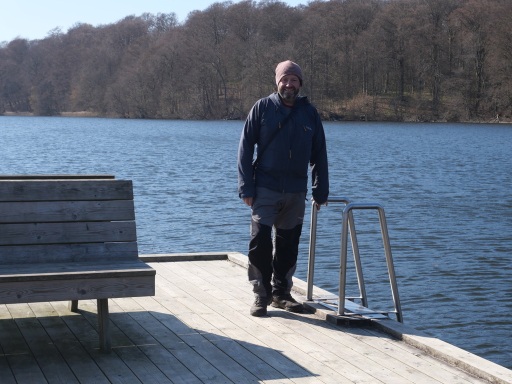

We stopped at one particularly great place called Stenshuvuds National Park (though didn’t actually camp here), its such a diverse area, with huge beech woodlands, rocky hills, ponds and of course amazing beaches, we had a great chat with a very helpful park ranger before setting off of a long walk.



Apparently it has suddenly warmed up here in Sweden (perfect timing eh), and of course that means the wildlife waking up after the winter. Here the Adder population had definitely woke up, we heard quite a few moving on the forest floor as we walked past, (though without seeing them it was hard to be sure what it was), but we did see a few and in their early spring colours they were beautiful.

This was without a doubt the longest Adder I’d ever seen, and moved quite quickly, especially with me chasing it with my wide angle lens on my Lumix!!
We also came across another slightly smaller one on the beach in the large pebbles, this one was getting slightly angrier at me trying to get a decent photo of him.

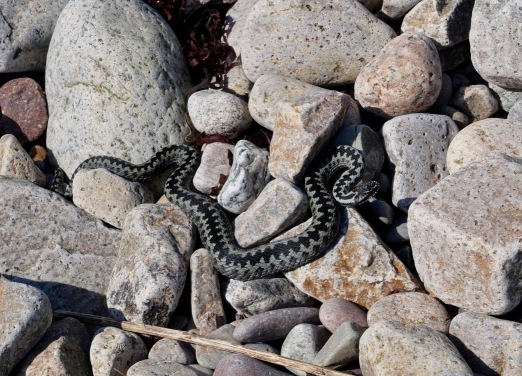
But gradually we started to move further north up the coastline, easter was approaching and there were defiantly more motorhomes about, though most of the time we camped on our own, we camped next to the sea, in the forests, and alongside small and large lakes.
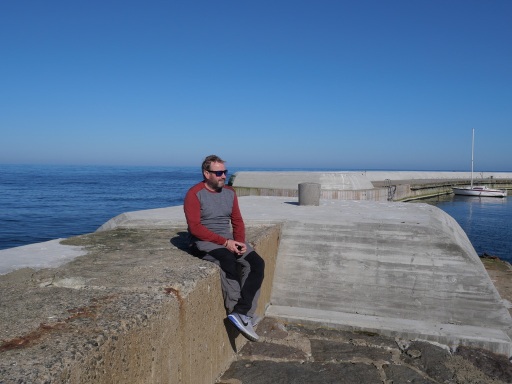
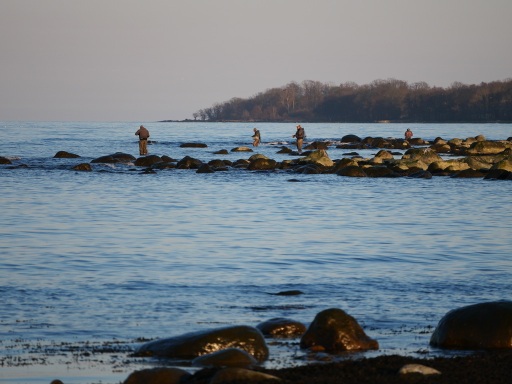


Whilst we were in Copenhagen we decided to completely empty our fresh water tank as we were on a campsite, and could then start with ‘new’ water on board (we drink water direct from the tank, so occasionally refreshing the water supply, and of course a couple of times a year a total clean out with special solutions is important), after filling back up with water I noticed that we had a slight leak, a slow drip coming from the drainage point. hoping it would settle we carried on, the dripping didn’t disappear, and it was far worse when we had a full tank. I tried undoing the drain again and quickly doing it back up ultra tight, but still it dripped. This went on for a couple of weeks, and although we didn’t want to visit Stockholm we might have to now to take a trip to the main Hymer dealer there. With another 5 months of travel in front of us, I couldn’t risk the leak getting worse. I contacted our friendly Hymer Owners Group facebook page, and apparently it is not unusual in a new motorhome with our type of drainage tap, and can be caused by debris in the tank getting stuck in the seal when its closed. I tried again (losing a bit of water every time), still bloody dripping!!!!
Then one morning as we were wild camped next to a stunning lake on our own, and an easy drive to Stockholm, I decided to give it one more go, and give it some welly this time, really agitate the seal under the plug, sure enough there was a tiny burr of clear plastic in the bucket i’d placed under the drain point, it was obviously from when they had cut the hole in the tank!!! All was now well in Swedish Hymer Land, no drips but more importantly no need to go to Stockholm.




As we turned north, the place becomes more rural, lots of forests, small villages, more forests, smaller roads (even the main ones), lots of lakes and forest after forest. Wild camping opportunities are almost endless especially with all the access tracks into the forests. After 12 nights in Sweden so far we have paid for camping for one night. We have decided this for a number of reasons, obviously cost is a big factor (this wild camping has saved us approx £300 so far in Sweden alone), but also its a far nicer experience for us, being on our own (mostly) and in a much nicer environment. We plan to use a campsite generally about once a week, to use laundry services for stinky clothes, towels and bedding, and also to plug in and charge everything up, including our leisure batteries (this does them good, rather than just relying on the vehicle alternator and solar panels).



We are probably about as far north as we will go in Sweden, before we head over to Norway, and are currently camped on a small island on a huge lake called Siljan, (its actually the 6th largest lake in Sweden) in a tiny harbour area. This as much as anywhere that we travel to, throws up the occasional surprise. Despite it being quite warm out of the wind (its a maximum of 20c during the day), there is still snow in many places (theres a ski area in the hills just off the island that looks like its still got a good covering).

This may look cold but once back from our walk (where we bought an ice cream), we were sat out having a Gin and a Rum, about 100 metres from where the snow photo was taken!!!

We had wild deer around the camper in the evening, and then to top off an evening of pleasant surprises, a half dozen young Swedish women decided to perform some sort of crazy speedied up version of Tai-chi on the jetty in front of us!!! like I say surprises, some I don’t like, but most I do.

Thanks for reading, from a sunny, and still rain free Sweden,
Vince
Trading places….or downsizing campers.
As most of you will know up until the end of 2018, we had for the previous 7 years been using/travelling a ex-military Leyland Daf 4×4 truck with a fully loaded weight of nudging 10 tonnes, we are now travelling in a Mercedes Sprinter 4×4 based Hymer built motorhome, with a gross weight of just over 4 tonnes, so whats the difference and what are the pros and cons of each setup?
First of all, Colonel K our trusty Daf overland truck served us unbelievably well, especially on our 3 years travelling the African Continent. It was based on a 1991 vehicle that was designed in the 1980’s, with mechanicals to match. In other words, simple to fix in the field, with zero electronics, just what you need in Africa. Indeed many local “bush mechanics” recognised the engine as soon as they saw the 5.9L Cummins unit. Whilst the truck, engine wise, remained incredibly reliable, (it was very low mileage), the rest of the cycle parts, drive train, hydralics, brakes, electrics, fuel system etc did need constant fettling and maintenance. Not a major problem if your slightly handy with a basic tool kit, but did wear on us a bit at times, after all it was a 25 plus year old vehicle that had been standing around most of its life.
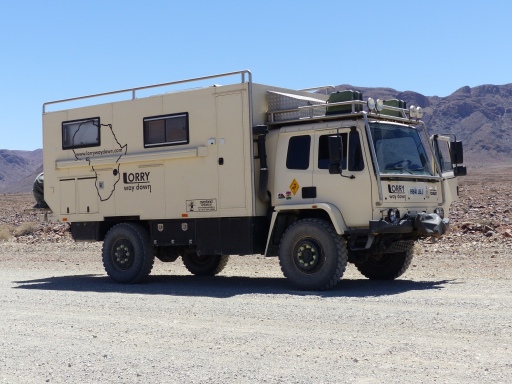
Whilst we both had our HGV licences, Jac was never happy driving Colonel K, the Daf’s are a bit of a beast to drive, and I always felt that Jac was missing out by not driving. With this in mind we hatched a plan to get a smaller vehicle of some kind.
The next question was, what base vehicle do we go with on a new camper? one thing that has always remained constant is our love to explore slightly out of the way places, wild camping plus, if you like. We wanted to maintain the ability to explore down that forest track, or to drive on that beach, or not worry about ground clearance, in other words it must be on a 4×4 chassis with the added clearance that that brings. So if we wanted to stay below 7 tonnes, and reduce the size to something more European friendly, the options at the moment are Mitsubishi Fuso/Canter on a 4×4 6.5 tonne chassis, Iveco Daily 4×4 Chassis cab, or Mercedes Sprinter 4×4. There are other slightly more obscure military based options, but they are not mainstream enough for us. With the Fuso or Iveco we would have to go to a custom builder (probably in Germany or Netherlands), and the costs are quite frankly crazy (anything from £180,000 to £300,000), so Mercedes Sprinter it is then.
Next question is 3.5 tonne of 5 tonne chassis? And of course where do you get it built? To cut a long story short, we had found a builder in Germany that agreed to build us a 4×4 Sprinter based camper to our specification and at a price that was “reasonable”. The slight spanner in the works was that Mercedes were not building any Sprinters at all in 2018, due to the imminent arrive of a facelift model. The 4×4 specification models would be the last to be put on the production line and there was no definite date as to when delivery would be…. mmmmmm.
Then while we were in a cafe in Oban, North West Scotland in the summer of 2018 in the Daf, we saw an advert for a brand new special edition Hymer motorhome based on a Mercedes Sprinter 4×4 Chassis cab, and to top it all it had uprated suspension and had a gross weight of 4,050KG. “Could we actually go from a burly overland truck to a posh motorhome?”. We rang the dealer and put a holding deposit (fully refundable) on it, ‘Our’ actual camper wasn’t due in from Germany for another few weeks but they had another one almost identical that had been sold but not collected yet, so we drove down to the dealer in the Midlands on the way back to Kent to have a look.
Wow it’s a bit bloody posh!! It’s a special 60th edition, and so comes with a very high specification (including many things that we normally wouldn’t have ordered on it), including full leather seating, satellite system and 32” TV, but it has got most of the things that we wanted. So the deal was done, and extras were ordered, mainly to make it a bit more wild camping friendly, including, additional leisure battery (and uprated charger), 1800w inverter, solar panels, and the indispensable SOG filter on the toilet.

So how does it stack up with the Daf? Obviously its brand new mechanically so theres no point in going into that side of things. First of all the Sprinter is amazingly easy to drive, its on the standard wheel base so turns really tightly, and its oh so smooth, especially with the auto gearbox.
But living with a much smaller vehicle, hows that working out? Well actually really well, especially in the colder and wetter conditions. Although Colonel K was a much bigger vehicle (8.0m long by 2.6m wide, compared with Zorro’s compact dimensions of 6.75m long by 2.1m wide), the internal living space is much better thought out, and the difference isn’t so great (12.5m2 of floor space compared to 9.75m2 in the Sprinter). We still have seating for 4, a decent sized table, a double bed, a kitchen (with sink, 4 burner hob, oven and grill), a shower and toilet.
There is also a least as much storage inside Zorro as there was in Colonel K, plus (and this might surprise a lot of people) theres a lot more storage externally in the Sprinter with the “rear garage”, its simply massive. I’ve actually rigged up a net as a hammock type storage system to utilise the height of the through area. We’ve also rigged up some stacking heavy duty storage boxes just to tidy up the various items/supplies.
So what are the down sides to going to a “normal” motorhome? The biggest for us is reduced payload, especially the maximum rear axle weight. When we were in Kent we took it to a weigh bridge in a normally fully loaded state, (full of diesel, about 60-80 litres of water, and full of clothes, food, and Jac’s gin stock) and we were nearly 3,750kg, this meant that we could legally carry another 300kg of stuff. But and its a big but, we only had an additional 50kg spare left on our rear axle!!! Thankfully the Mercedes is a rear wheel drive vehicle (when 4wd hasn’t been engaged), whereas Fiat’s are all front wheel drive and it would be much more serious for extra weight over the rear. Even so staying within the strictest of laws in relation to the rear axle is going to be a challenge. Bearing in mind the huge amount of payload that our ML-T 570 had even after the special edition bits and the extras that we had fitted, I do wonder how many motorhomes are driving well over their legal limit.
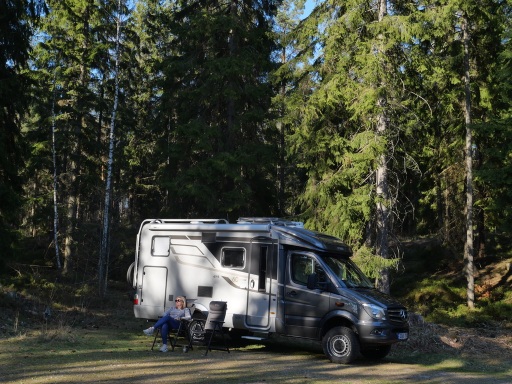
Another thing that we have had to get used to is the smaller water tank. Colonel K had a massive 300 litres of fresh water on board, but we realised that we never needed that amount, even in East or West Africa. But I think our optimum amount would be 160-200 litres, so our new campers water supply of 120 litres has taken some getting used to. We like to wild camp most of the time where possible, indeed as I write this we have been in Sweden for 9 days and only used a campsite for one night, so to help our water situation we carry four 10 litre water storage containers (food grade), this then gives us a total of 160 litres. This will comfortably allow us to camp for a week or so off grid (including a quick shower every so often).
The shower is a very ingenious design, where the back wall of the WC with the sink on it hinges round and clips back to form a wet room shower area, its a great system but it is quite cramped compared with our huge shower in Colonel K,
Are there any plus’s of going smaller? Hell yeah!!! We don’t worry about heading down small roads (especially in tiny foreign villages), its very smooth and easy to drive, the gas or electric Truma is incredibly efficient at heating the water and the interior of the camper (just set the room stat and leave it be). The refillable gas tanks (22kg which is 42 litres) have proven invaluable, being cheap and easy to use.
The Sprinter has now covered just over 4,000 miles (6,500 kilometres), and since we’ve had it, its done an average of 24mpg, the engine is obviously still new and i’d hope this might improve slightly, but roughly that is 800 litres used so far (or just over £1,000), in our Daf that would have been approx double that amount or an additional £1,000. I estimate that we will spend approx £3,000 less in fuel on our Scandinavian trip this year with our new camper.
The other matter is the complexity of having Euro 6 diesel vehicle and the issues that this might cause in other places around the world other than Europe. This will be an issue if we take it to South America or the more remote areas in Africa, or central Asia, but most countries (such as Australia, New Zealand, Canada) that we want to ship to are now adopting Euro 6 vehicles, and if the worst comes to the worst we may have to have the emissions, and engine management adapted to suit before leaving the UK.
We saw quite a few newer Sprinters in Southern and Eastern Africa, these were Euro 6 and running Adblue and they were coping fine and proved reliable. It was actually in Tanzania that we first saw two Hymer ML-T 4×4’s and they were holding up well (even if they do look a little weedy next to an ex military overland truck).
This brings me to my final point, we decided that we needed to be honest with ourselves about what we wanted from this huge investment in a vehicle. It had to be super reliable, easy to drive (including as we get older), its only ever going to carry us two, and we probably will never drive on that crazy dirt track in the wet season in Mali, stuck in mentally deep mud and surrounded by locals carrying AK47’s!!!!!
So far its working very well and all is well in Zorro World
Thanks for reading
Vince
Cross the Channel and away……
We left the UK at the end of March, and for the first time in a camper used the channel tunnel to get to France, this was quite a weird feeling driving a 3 metre plus high vehicle onto a train that normally feels like its going to take your head off when boarding on a motorbike. It proved to be a good choice, being only about £20 more than the ferry but also much faster and flexible (we actually got on two trains earlier than planned).
Our original plan was to meet some friends from Germany that we met over a year ago in South Africa in the Belgium town of Brugge, but they felt that it was still too cold for them to camp with their 2 year old daughter Elizabeth. They are planning to spend a few months in Turkey, Iran, then north and back into northern Europe later this year, they wanted to borrow our Satellite Phone for this trip. We decided to go to Brugge anyway, and we were very glad we did.
We found a campsite within walking distance (about 5km) from the old town, and were wowed by the place, really stunning. I know that a lot of you will have visited this famous town before, but for me (not Jac) it was a first.


Along with the rivers, huge churches and medieval buildings, there is a great cafe culture, this was obviously helped by the glorious weather that greeted us that weekend.


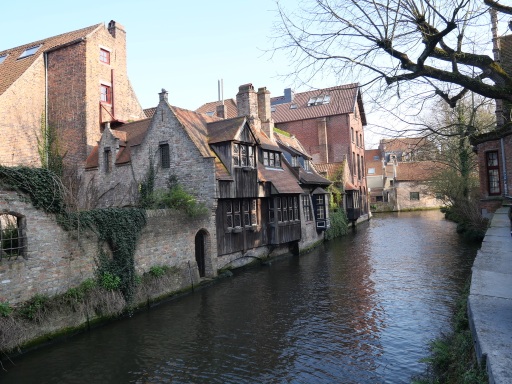
We spent 2 days in Brugge, but it was now time to head south through Belgium, Luxembourg, and France before turning east across into Germany to see Tim, Sarah and little Elizabeth in their home town of Bad Durkheim.
We had a lovely few days in this beautiful town, and were taken out and about by Tim and Sarah, unfortunately the weather wasn’t very kind to us and it rained most of the time, we went wine tasting in a local vineyard, had a pizza in a very german style restaurant, ate the biggest brunch known to man, flew drones, consumed mountains of ice cream, and generally had a fantastic time catching up with great friends.





Satellite Phone exchanged, hugs and best wishes for travels passed on, and it was time to leave Bad Durkheim and head north to Scandinavia, this is after all the main destination for this trip. Tim suggested we stay in Lubeck, which is a city in Northern Germany on the coast, on the way to Denmark. This is another great find, and well worth a stop off.



Lubeck is known for its Marzipan, its every where! There are streets selling virtually nothing but marzipan, I even had a marzipan latte. We walked for miles that day, from the campsite, around the city and then back to the campsite, and as you can see from the photo’s the weather was seriously hot.


Jac even met another little devil.

Next it was north once more into Denmark, and for the first time for a long time we were actually stopped at an EU land “border” by a customs official on the Danish side wanting to see our passports. All very pleasant and civilised but it did seem strange. Not sure if it was because we have GB plates on Zorro, or maybe they are practicing for post Brexit.
Our first night in Denmark was spent parked in the rear garden of a small farm over looking a small bay on the western side of the country about half way up (north sea side), it was cheap (for Denmark) and the owner was very welcoming, though a little surprised to see a British camper looking for somewhere to park.


The drive up this western coast is stunning in places, with some beautiful homes in the sand dunes.



One of the highlights for us up this coast line was the small town of Lemvig, we found a nice free camp in the marina area just outside the town and walked in for a coffee, its a lovely place with a great feel.




As you can see from the photos we were blessed with mostly cloudless blue skies, but it was cool, actually out of the sun it was quite cold, but at night the temperature tumbled. At this point, I have to say the insulation on the new camper and coupled with the gas heater makes us very happy with our purchase. Our old camper Colonel K, would definitely not have been as comfortable in these freezing conditions. The gas/electric Truma boiler fitted to the Hymer is much more efficient than our diesel heater/hotwater boiler from our old Daf truck (more on this comparison in a later post).
One place I really wanted to visit was the Sea Warfare Museum at Thyboren, this is located right on the tip of a long peninsula, and whilst it covers sea warfare from the whole of the First World War, its main exhibits are to raise awareness of the Battle of Jutland where the largest sea battle of all time took place over a couple of days just off the Danish coast not far from Thyboren. We didn’t have great expectations for this privately owned museum, but it was extremely interesting, and we were there for about two and half hours in the end.


There was a tremendous loss of life from both the British and the German navy’s (almost 10,000), and there is an area outside on the beach set in the dunes, where there are memorial stones set out with each ships name that went down during the Battle of Jutland, together with a representation of the amount of souls lost on that particular battleship. Its a very poignant place that really goes to show how many men lost their lives.


After leaving the museum we got on our first ferry of the trip, a short ride from Thyboron to Agger. We didn’t realise that the old ferry terminal wasn’t being used anymore, there were no signs to say so, and we sat there for about 30 minutes before another camper pulled up behind us and knocked on our door and told us that the ferries no longer leave from here they now depart about 2 km further down the road!

Next stop was “Cold Hawaii”, Klitmoller, apparently its very popular with surfers in the summer, there were none here in April!!!!!

They do have very luxurious sauna’s though.

Eventually we got to Skagen which is the tip of Denmark (actually its not quite, this is at Grenen and we drove up there the next morning). Looking on the map Skagen looks a bleak place, but it was actually a nice surprise. It is absolutely full of high end boutique type shops, this is because its very popular with Danish people in the summer, and also massive cruise ships now dock here and temporarily flood the town with tourists. We managed to get parked for free in the harbour area taking the last of 6 available spaces.


Grenen (the most northerly point), is a lovely beach and full of German bunkers, sunk into the sand, that were built during the Second World War, this was a massive defensive position.



From here it was a 550km drive to Copenhagen, not a particularly notable journey apart from the massive shock of paying £71.00 toll to cross the bridge from Kolding to Odense, we were expecting a high charge but blimey!!! And that was for a camper up to 3,500kg.
We spent a nice day in Copenhagen, getting the train in from near the campsite, but to be honest we aren’t city people really, and after Brugge and Lubeck we were a bit “city tired” if that makes sense. It was also extremely expensive with a pint of Guinness at nearly £8.00. We worked it out that for the price of one G&T and a Guinness in Copenhagen we could have had 2.5 G&T’s and 2.5 pints of Guinness in Cornwall. It was the first time ever that I refused to buy a drink in a restaurant while we ate a meal, with a small glass of house wine at about £10.00, so we just had fish and chips, much to the waiters horror.
It is a lovely city though, especially the harbour area’s with its famous multicoloured terraces with (expensive) restaurants below. It was busy there in April, god knows what its like in the summer!




And of course there’s the famous mermaid (along with 100’s of snapping tourists, like me).



Next we cross into Sweden, and another bridge toll, this time we have prepaid it at £84.00, thats a total of £155.00 to cross two bridges from Denmark to Sweden (gulp)!!! But I have to say both of them are very impressive and total almost 40km of bridges.
We loved Denmark, especially the rural west coast, if your in a camper and don’t eat or drink out, its possible to tour very cheaply, mostly we wild camped, though in the summer some of these free camps do actually have a fee charged.
We are looking forward to seeing what Sweden has to offer………
Thanks for reading
Vince
Back on the road again…….. but first a quick update.
Most readers of this blog will know that we have now sold our Leyland Daf overland truck, and purchased a new much more “sensible” camper, more of this in a bit.
Colonel K had one last hurrah before he was pensioned off, we did a 5 week tour of western Scotland, and we of course loved the place just as much as when we’ve visited here before, we spent a few days with good friends, Russel, Kirsty and Andy and Kate in their respective motorhomes. It was while in a coffee shop in Oban that we hatched a plan to buy “Zorro” a Mercedes Sprinter 4×4 based motorhome.
The Daf truck performed absolutely impeccably despite me carelessly driving it into a ditch, while swatting away a man eating, deadly wasp inside the cab!! Opps absolutely no harm done and of course the truck just drove itself out. On the way back to Kent we called into the dealer that had promised he had the 4×4 Sprinter coming in and looked at one that he had already sold. The deal was done.
The camper had already been built at the factory in Germany (Hymer) on one of the very last of the available 4×4 chassis cabs, so the specification was not negotiable but it was pretty much how we would have ordered it, plus it had a few extra luxuries such as a full satellite system and a 32” smart TV (posh eh). We then had a few dealer fitted items that we required, mainly to make it more suitable for more prolonged “wild camping”. These included a 1800w inverter, solar panels on the roof, extra leisure battery, a SOG filter (an absolute must in our opinion), a full size spare wheel (can’t believe these aren’t standard on a new motorhome), and a double cycle rack on the rear.
I priced Colonel K to sell fairly quickly and the first serious buyer that looked at it bought it, I wish them many happy times in the truck and if it looks after you guys like it looked after us during our 3 years in Africa (and our total of 7 years of ownership), then you’ll have a ball. I delivered the truck to its new owners and then caught the train back, a very strange day with lots of emotions running around my head.
But all things come to change eventually, and we picked up Zorro and put it through its paces with a trip to Norfolk, Yorkshire and the Lake District, after getting used to it (its a lot smaller inside than Colonel K), and getting a few teething issues sorted by the dealer (almost all due to badly fitted extras by the dealer), we were happy, very happy.

By now it was late 2018, and winter was approaching, we had agreed to house sit for some friends that we met in Africa in their beautiful old cottage in East Devon, we had a fantastic 6 weeks here getting to know the area. Our stay here was slightly tainted though, as we were asked to “pet sit” their tortoise, but were told that it was by now in semi hibernation and all we had to do was keep it packed with hay in its hutch which was in its enclosed run. When we arrived I thought id better check how far the tortoise was inside the hutch, after feeling around frantically and eventually pulling all the hay out, it was obvious that the little reptilian was gone!!! We had one thing to do while here, look after their beloved pet……. and it was gone!!!! We searched the garden for weeks, relatives searched and even dredged the pond, nothing!!!! We informed the owners who were very cool about, but guilt had seriously set in, there was definitely a reptile rustler in the village.

After Devon, we spent the rest of the winter in west Cornwall, we’ve often thought that maybe we will eventually end up in the west country in our twilight years so thought it was a good opportunity to see the area in its worst weather, but we still really like it there. We had lots of family and friends come to stay with us in our holiday cottage (actually a 4 storey four bedroom new terraced house), and we had some real quality time with them all.





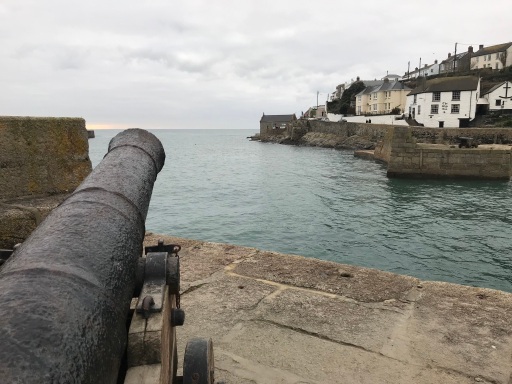

But eventually we had to leave Cornwall (evicted again haha), and it was back to Kent to get Zorro ready for our next adventure, a six month trip round Scandinavia, including a drive deep into the Arctic Circle to Nordkapp in Norway.
I ummmm and arrrrrred about whether to carry on the blog of our travels, but have recently had a few people ask me to carry on writing it, on a selfish note it has actually ended up as a great diary for Jac and myself (this has definitely proved the case for our Africa trip), so I am going to carry it on. Yes I understand that Norway and Finland aren’t quite the adventure that Burkina Faso and Rwanda are, and Zorro is not quite as mega, burly, rufty, tufty as Colonel K, but we still plan to visit slightly different out of the way places and certainly to camp “off grid” as before.
I will soon put on Lorrywaydown a more detailed spec of Zorro, and the pros and cons of a compact off the shelf motorhome (though with 4×4 and huge ground clearance), compared with a 4×4 ex military overland truck, in the meantime we are loving being back on the road………
STOP PRESS after 6 months of worry the bloody tortoise turned up, he’d escaped his fenced run under my watch and buried himself under a tree for the winter!!!!! Dogs are so much easier.
Heavy Heavy Heart
It is with a very heavy heart that I have to tell you that Colonel K, our trusty Leyland Daf overland truck, has been sold.
I like to think that he has got a new custodian rather than a new owner, but either way very soon Colonel K will no longer be our responsibility, and whilst I know that his new master has great plans for him, there were very mixed emotions after agreeing the sale.
As you will know we have had a fantastic 3 years in Colonel K in Africa, and it proved a perfect way to travel the “dark continent”. Since we got back to the UK earlier this year, we have had an amazing 5 week trip to north west Scotland, doing approx 2,000 completely smooth running, trouble free miles. This was a terrific last experience in Colonel K.
So is this the end of our travels?? Ha ha…….. Absolutely not!!!
We now have a much much smaller vehicle based of a 4 wheel drive Mercedes Sprinter (chassis cab, not van based), and we have plans…..
Thanks so much to the 49,750 people that have viewed this blog (so far), and I hope that you might have been slightly entertained and more importantly been inspired to just get up and bugger off on a trip of a lifetime.
To be Continued (soon)………
V
Colonel K is up for sale
We’ve taken the tough decision to sell our trusty Overland Truck, Colonel K.

Here is a link to the advert on ebay
https://www.ebay.co.uk/itm/253860162381
We are after £38,000, or €43,000 for the truck and the mountain of spares and accessories.
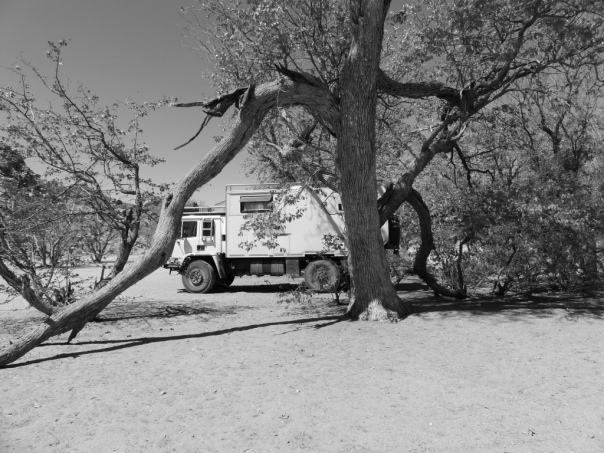
Below is an honest description of the truck right now.
For sale is our professionally built overland truck, this has been well proven and we lived in it exclusively during our 3 year trip to Africa (details can be seen of this trip on our blog http://www.lorrywaydown.com. ). It is designed and built to be very self sufficient for long periods of time, we have camped “off the grid” for 2 to 3 weeks many times during our ownership.
Please note the truck is Left Hand Drive and has a Gross maximum weight of 10,800kgs, so in its current state cannot be driven on a standard car license. It is registered with the DVLA as a Motor Caravan and the road tax is £165 per year. As its a Motor Caravan it gets MOT’ed annually as a “normal vehicle” and not as the more stringent HGV tests. It is currently MOT’ed until March 2019.
We got put on a weigh bridge in Namibia and with a full tank of water, fuel at about 75% full and completely fully loaded for a 3 year trip we weighed 9,200kg.
We currently have Bridgestone tires on the front and Michelin tires on the rear, these are semi off road tyres and suit the truck very well doing a combination of road and off road use, all have got plenty of tread left.
The truck is in very good mechanical condition, but it does need a bit of a “freshen up” inside and out, especially the interior joinery, cupboards etc as these were slightly damaged by a water leak while in Uganda in the rainy season, but it is obviously water tight now.
The Leyland Daf T244 started life with the British Army and was manufactured in 1991, we bought it from the military disposal centre of Whithams in 2011. The truck was delivered to Overland Vehicles Ltd, based in Suffolk, England and from during the end of 2011 to beginning of 2012 Ed Perry constructed what we have today. We took delivery of our completed overlander in Spring 2012.
The living accommodation box is fitted to a full 4 point torsion free system, this separates the twisting forces of the chassis rails from the living box (very important on these large trucks as the chassis rails are designed to twist under off road conditions). This means that the accommodation box is fitted to a separate subframe/floor.
The construction that we specified with Overland Vehicles Ltd was steel box section and clad with aluminium externally, then rigid insulation between the steel members, and then a further layer of rigid insulation over the inside walls and roof/ceiling. The floor is also fully insulated.
The Leyland Daf is fitted with the ultra reliable Cummins 5.9L turbo diesel engine and 5 speed Spicer manual gearbox, it is permanent 4 wheel drive, and also comes with a high/low range gears via the lockable centre diff. This all works like a very big Landrover Defender, but in a much more robust and stronger package.
The vehicle is very very low mileage, despite us using it on a three trip to Africa, with a total mileage of less than 80,000 miles (we purchased the truck with less than 2,000 miles on it). It has proved incredibly reliable and very capable off road, with only minor issues during our long trip. Due to the simple mechanics of the LD it is never a problem to get any issues easily sorted, even in the most remote of areas.
I have changed the engine oil and filters, at a maximum of 6,000 miles religiously and the engine uses barely 1 to 2 litres to op up between oil changes. Gearbox, transfer box and diff oils were last changed about 10,000 miles ago.
It has recently had both track rod ends replaced, drop link to steering replaced, fan belt tensioner replaced, brake shoes relined, UV joints to prop shafts replaced, plus ALL of the batteries replaced.
There is also a massive selection of spares with the truck, including alternator, clutch plate, water pump, injector, fan belt, hoses, complete new replacement burner unit for the Thermo 50, filters, headlamp unit, spare driving lamp, spare bulbs, spare made up cables for rear hoist, throttle cable, rad cap, thermostat, fan belt tensioner, 2no replacement hub nuts (very hard to get hold of), spare wheel nuts, spare 24v to 12v dropper, spare mirror lens, 12 tonne bottle jack and blocks, two truck specific wheel chocks, Michelin inner tubes, wipers, syphon kit fro transferring full, throttle return spring, heavy duty 240v battery charger, gas rams for roof lights, etc, etc, etc.
I also have all of the original instructions for all of the fitted equipment such as inverter, charger, air con unit, TV, music systems, diesel hob etc.
There is a full paper copy of the parts manual showing diagrams and every part number for the whole truck, plus a user manual (instruction on how every thing works, and a full maintenance manual, showing oil capacities, greasing points etc etc.
So, now a bit more detail on the truck itself.
The living accommodation box is approx 5.0m x 2.5m externally, and has full headroom inside.
It is fitted with a 300 litre diesel tank (this has always proved to be more than enough even in rural west africa).
It is fitted with a 300 litre fully baffled PVC water tank, with water pumped by a 30psi 24v water pump (replaced with a new one 12 months ago). The water tank and pump are located under the bed in a fully insulated and heated position. There is a large bore drainage pipe with a stopcock for rapid draining of the water tank that discharges under the rear of the truck.
It is fitted with a 150 litre grey water tank, this is semi insulated and accessed and drained from outside.
The gas locker contains 2no 6kg propane bottles (both full), as the only use for gas is cooking these usually last for many months.
There are 4no 110ah leisure batteries wired as 24volts this gives 220ah at 24volts (replaced in 2017). When constructed we had it built with 8no 110ah batteries, we felt this was too many and so reduced this to 4 batteries, however the space and wiring is still in place should you wish to go back to a huge bank of 8 batteries.
Charging of the leisure batteries is taken care of my the excellent and reliable Sterling Power Products Alternator to battery charger, and Pro Combi S Pure Sinewave Inverter Charger. Of course there is 240v mains hook up with trip fuses, and a large fixed solar panel on the roof which I think is 180w and wired through a Steca Solarix MPPT solar charger controller. All the Sterling equipment is controlled remotely from switches in the kitchen.
There is also a Honda 3.0is petrol generator fitted on a heavy duty slide out in an external locker, this charges the batteries very fast, and allows the you to live truly off the radar. This generator operates very quietly, and has been hardly used, (less than 50 hours), this alone cost over £3,000.
Hot water is provider via a large calorfier which is heated via the engine cooling system (as soon as the engine reaches full temperature, you have very hot water for use), or via the Webasto Thermo 50 Diesel Water Heater, you never want for hot water in this truck. In practice the Webasto is rarely used as the engine cooling heater is so efficient and the water remains hot for a couple of days in the insulated calorfier.
Heating is via hot air outlets.
Specification room by room
Kitchen
4 burner Gas Thetford Minigrill MK111, with built in grill underneath and glass lid.
Webasto X100 diesel hob, with Schott Ceran ceramic hob top, fully adjustable and with altitude control. This is another high spec item (well over £1,000) that enables a truly go anywhere attitude. This has had very little use as its a back up for when gas is not available. It also makes a fantastic method of heating the living accommodation.
Large stainless steel sink with built in drainer, foldable mixer tap and glass lid.
Nature Pure water filtration system with dedicated tap, never buy bottled water again!!! This system removes everything and was a massive plus in Africa, we literally never had to buy bottled water.
All of the above is set in a 2,200mm worktop made from a heavy duty resin material in a “speckled white” finish.
Waeco built in front opening CR-110 Compressor fridge, complete with built in ice box/freezer.
3no large under worktop storage units, and 4no overhead storage units (one of these contains the main electric controls, including amp counter, voltage display, inverter switch, all 12v, and 24v fuses, plus 240v sockets). Down lighters built into under side of overhead units.
Bathroom and WC, separated by door from rest of unit.
Large “full size” shower with curtain and adjustable mixer control, this is a fantastic shower that has a high flow of hot water.
Thetford toilet with cassette accessed from outside locker door. This is fitted with a 12v SOG extractor unit, as such we have never needed to use chemicals in the cassette, and there is no issues from smells.
Sink built into a large vanity unit, with mixer tap, top is same material as kitchen worktop, mirror fitted above.
Living area
Large seating area for 4-6 people around table. 1200mm x 750mm table in same material as kitchen worktop, all of this easily and quickly converts into a 2nd double bed.
Full height large wardrobe with shelves, double doors.
19″ Dyon TV with built in DVD player, (inc remote control), built into a high level shelving unit, please note there is no ariel for TV, we only used it a few times to watch DVD’s.
Sony DSX-S100 Digital Media Player, this is a 12v car unit fitted under the shelf unit, and can play music from iPods, USB sticks etc, this is not wired to an external ariel, 2no Pioneer speakers.
Large opening panel above the table in outside wall, top hung and fitted with gas rams and pull handles, fitted in this is a normal window.
Cut through to cab.
24v fan fitted at high level.
2no double 240v sockets and a 12v “cigarette type” outlet for charging accessories.
Dometic B2600 air conditioning unit fitted into roof/ceiling, inc remote control, this has been hardly used, and does require a good 240v hookup for it to work efficiently.
Large opening roof light over table area.
12no individually switched low amp downlighters set into ceiling.
2no large storage areas under seating, some also accessed via outside locker door, there is also a hidden area under a false floor here that contains a lockable safe.
Water tank level gauge, heating and hot water controller, and timer.
Sleeping Area.
Full size double bed, 1400mm x 2000mm, this remains made up and no need to pack away, we also have in position a very high quality Vispring mattress, this is 100% natural materials and very breathable, a huge bonus in hot climates, its also very comfortable.
1no window, a large roof light above the bed, and a 24v fan. Smoke alarm and carbon monoxide alarm.
3no large overhead lockers, down lighters and steps to access the bed.
Outside.
There is a recovery winch fitted on the front and rear of the truck, each of these are the excellent 24v Warrior EWX 17,500Ibs units, these have a maximum pulling power of 8.0 tonnes, and they have proved their worth in Africa, and have remote control cables for ease of use.
There are tow points on front and rear with large heavy duty shackles, and a heavy duty snatch block.
There is a large wind out awning fitted to the side (there is some damage to this as the hinged arms are no longer fitted but it is still very usable, it just needs guy ropes to peg it out).
Hammock fitting point (yup you read that right), we have actually used this a lot.
Easy access fold away steps, very easy and light to use and a safe way to enter the living space, they literally just pull out and roll down.
Rear rack operated by top mounted electric winch, this was originally built to carry two smaller motorbikes, then we carried one larger bike (a KTM 990 Adventure), then we adapted the base to take the spare wheel, and two mountain bikes, this is how we set off for Africa. During our trip (in Namibia) we sent our mountain bikes home and then cut off the protruding base beyond the spare wheel. This would be very easy to made a new base if the buyer requires to carry a motor bike again.
External shower point for hot/cold shower with handset.
Battery isolator switch for starter batteries, these were replaced in 2017.
Stainless steel large (50mm diameter) protection rails to front and roof of accommodation box, stainless steel protection “cage” over air conditioning unit on roof, stainless steel protection up the corners of the cab, and forming the roof rack over cab. There is a stainless steel ladder on the side of the cab to access the roof rack and roof from the wheel arch. Whilst these are heavy they have proved invaluable in protecting the truck.
Large aluminium purpose built lockable storage box on cab roof.
2no double jerry can holders on cab roof carrying an additional 80 litres of fuel if needed. Please note these jerry cans have never been used and though the holders are in excellent condition, the actual jerry cans are a bit rusty.
There are four high power driving lamps on the roof of the cab, these are a real bonus when driving at night as the standard Leyland Daf headlamps are quite poor.
Inside Cab.
The cab is a large design with a big area behind the seats, and have seen these converted to carry 4 people.
Fitted are two mechanically sprung KAB 411 seats which are weight adjustable, fitted with head restraints, and foldable arm rests, these are very comfortable for covering long distances.
The cab has been fitted with sound proofing from the engine underneath.
Engel top opening compressor fridge is fitted behind the drivers seat, there is a large area behind the passenger seat for storage boxes etc.
Large lockable purpose built metal storage box fitted between the seats this also contains a Sony DSX-S100 Digital Media Player, this is a 12v car unit, and can play music from iPods, USB sticks etc, this is wired to an external ariel mounted on the cab roof, 2no Pioneer speakers are recessed into the storage box. There are two 12v charging points also inside the box. A purpose built metal tray is fitted in front of this to put, bits and bobs in.
Two 24v fans fitted to the dash board and a12v charging point is fitted into the dash for the Sat Nav.
Gun hatch/sun roof is fitted into the cab roof, and there is a cut through into the living accommodation, we have never used this.
Fitted is a Autowatch 457RLI remote controlled alarm/immobiliser, and Autowatch tracker system, I have all the papers for these items.
There is a high level intake snorkel kit fitted.
Ok now the bad points.
The speedo has packed up, and I think it needs a new sender unit (gearbox mounted), this packed up in Senegal and we recorded the rest of the truck on our trusty Garmin. The speedo is currently showing just over 12,000 miles, and that is what is shown on the MOT that was done in March 2018.
As mentioned above there was some water ingress while we were in Uganda and we couldn’t get this repaired properly until we got to South Africa, here everything was stripped off the roof including solar panel, air-con unit, roof lights etc and completely resealed before refitting. It has obviously not leaked since but some slight damage was caused to the units in the kitchen, they aren’t too bad but I need to point this out.
There is a reversing camera fitted but please note this is currently not working, it may be a wiring issue or may need a new camera unit on rear.
There are a few spots of rust on the wheel arches (the Daf’s are known for this).
There are a few bumps, scrapes and dents in the external aluminium of the living accommodation.
The cab is a little tatty now, with the sound proofing lifting in places, and a tiny solder burn in the drivers seat, but really its not too bad, it was built in 1991 !!
It still has our http://www.lorrywaydown.com stickers on (should be easy to remove I’m told by the guy that fitted them), and of course our prized African stickers on the passenger side.

But on the whole this is one hell of a high spec overland truck, that has proven simple, reliable workings, the price reflects that I don’t have the time to spend getting it back to “showroom” condition. It really is ready to go, to either live in full time, or as an expedition vehicle for that epic overland adventure, trucks like this with this high specification rarely come up at this price, but we have decided to get a much smaller vehicle for our next travels.
you can email me on vmartin555@btconnect.com
Thanks for following us on this part of our travels, but please note it continues………
Vince & Jac’s
Its been a blast…….. so far……..


Xmas and New Year, a real chillin’ time
Christmas and New Year is a difficult time to be camping in South Africa, because as we are in the southern hemisphere it is their summer and so for about four weeks everyone goes camping crazy. We found this out the hard way in 2015, the first time we spent christmas over here.
Jac had really wanted to revisit DeHoop Nature Reserve on the Cape Overberg peninsular, a couple of hundred kilometres east of Capetown, but we were told by the company that manages it, that the campsite here was closed with no date to re-open. So we bit the bullet and booked into one of their “Camping Rondavels”, this was literally a round building with a bed and a sink in it and not much else. There are 5 of these here and all have to share toilet and shower facilities (two of each and all completely outside with no roofs). The cost of one of these was £75.00 per night. This was obviously a lot more than we usually pay for camping, but camping prices are increased over the holiday period so we would have been paying £40 to £50 anyway (especially on this southern coast). Try getting accommodation over the xmas period in the UK for £75 per night!

The big plus for us was the fact that they put us in the 1st room (called Black Harrier) and this meant that we didn’t have to park the truck in the small carpark. We managed to squeeze it in down the side and right next to our outdoor seating area. It was so close that we tied our washing line from the truck to the Rondavel. In actual fact the room was great, and of course we are used to shared ablutions with camping.


The seating area outside our “luxurious pad” overlooked the lake and it really is a bird spotters paradise, it is teaming with all sorts of birdlife, and the sunsets here were, as always in Africa stunning.


DeHoop really is a great place for a holiday break, they have a massive assortment of accommodation, from our most basic room to luxury family units in huge old colonial buildings.



There are two outdoor swimming pools (one that is adults only in the spa area), a bar and restaurant, limited game driving, and access to a stunning beach (though this is a 15km drive on gravel roads from the main area). We stayed in our Rondavel for 8 nights and loved our time here.
For many people including us, the main attraction is the access to the stunning coastline, the blue waters of the Indian Ocean, are beautiful and at the right time of the year this is the number one spot for land-based whale watching in South Africa. Alas it was not the right time and subsequently we didn’t see any whales, but we did take Father Christmas with us……





The other thing that we like about DeHoop is the hiking trails, both in the coastal area and also into the Fynbos (scrubby arid terrain) around the lake. I sometimes think that we worry about snakes too much on our walking trips in Africa (meeting a Black Mamba in the hills near Windhoek, Namibia didn’t help, oh and nearly treading on a snake in the Ghana coastal rain forest…..), we know they are about, you just don’t see them.
At DeHoop we heard of a few encounters with snakes while we were there, a Puff Adder in the middle of a walking trail, the restaurant manager showing us a photo he had just taken of a Boomslang in the staff rest area, and incredibly (and much to my annoyance) the “adult only pool” had children in it due to a Cape Cobra refusing to leave the side of the “family pool”. But when out walking we try to do heavy foot falls to create vibrations and scare our reptilian friends off before we get to them (this method doesn’t work with Puff Adders though they just stay very still, and bite if stepped upon). This does work…….99% of the time.
One morning we had been out in the Fynbos for just over an hour, on a trail that we hadn’t been on before, when we came out into a small clearing by the lake side, about a metre from where we came out of the bush was a massive Cape Cobra! The stunning but deadly ‘coppery yellow’ 5 foot snake thankfully took one look at us two and decided to go the opposite way, very very quickly…. wow that was just a little bit too close for comfort! After briefly discussing the current state of our underwear, and giving the bush that it had disappeared into a wide berth we decided to carry on. After another 15 minutes I could see that Jac was still a little shaken up by the experience and so we decided to head back to the restaurant for a calming cappuccino . A quick google search confirmed that it was definitely a Cape Cobra and indeed one bite had enough venom to kill up to six adult humans mmmmm gets yer thinking eh.
The photo below was not taken by me, if I tried that, Jac would have killed me even if the cobra didn’t!!!


We had dinner in the restaurant a couple of times in DeHoop including a stunning meal on Christmas Eve, and for once eating out on this trip lived up to expectations, staff here were very friendly and we even talked them in to letting us camp here for two nights after our 8 days in the room (£18.00 a night, thats more like it).

But after a total of 10 nights here it was time to move on to the second part of our pre-booked Christmas and New Year at Bontebok National Park.
Bontebok NP is very close to the “historic” town of Swellendam, and before we made our way to the campsite we first had to try to get two new 12v starter batteries. The ones on board Colonel K were simply not holding their charge as fitted nearly 7 years ago. As it was between christmas and new year almost everywhere was closed, and the batteries have to be the exact same size or they won’t fit in the battery box, eventually we found a place that was open and sure enough he had two in stock, nice one!
Despite the campsite being full we had a real stroke of luck and managed to get Colonel K parked in a fairly large and secluded spot, especially important as we were expecting our German friends Tim, Sarah and little Lady Elizabeth to join us here for a few nights.
First things first though, as it was new years eve we had to put up the Union Jack Bunting on Colonel K, this still didn’t stop the South Africans asking where we were from though.

Bontebok NP really isn’t a place that you go to for game drives, its a very small National Park and was set up with the sole purpose of protecting the tiny numbers of Bontebok. Incredibly at one point only 17 Bontebok remained in the wild, but now thanks partly to the park here, the numbers have recovered dramatically, indeed we saw many while out walking in Dehoop.

But its a nice campsite with a great river to cool down and swim in and there are also quite a few hiking trails.
“Ze Germans” joined us after a couple of days and squeezed onto our campsite , and we had a fantastic New Years Eve celebrating with them.



Of course “Lady Elizabeth” was as cute as ever and really is starting to perfect her ” royal wave” to her subjects! One day Tim and I took Elizabeth to the local spar supermarket in Swellendam, boy did she attract some attention, and she seemed to absolutely lap up the attention, especially from the ladies. Though what they thought of Me and Tim, and no women mmmmm…… not too sure about that.

Elizabeth did however have her reservations about our numerous camp visitors, that soon learnt that where she sat, it meant food.

The River Breede was very welcome especially during the heat of the afternoon, and we found a use for one of the many inner tubes that we brought to Africa (obviously expecting many punctures), these big tubes make great flotation devices, oh and Tim had a tiny football. Boy did we have sunburnt heads one day…..



After Bontebok NP we headed for Ebb & Flow campsite in The Garden Route National Park, near the town of Wilderness and we are currently still here as I write this. This is another place that we have stayed before, and again a great place for walking and swimming in the river. Of course this is still a busy time and the campsite is full most nights with families on their holidays, mostly from Capetown (about 5-6 hours drive from here). The beaches however are incredibly quiet and empty and of course the sea is quite warm. We have walked a couple of times into Wilderness (about an hour and a quarter each way) along the mostly deserted beach paddling along in the surf.



And the hiking up into the hills from here is very nice, especially as most of it is through the indigenous forest and thus mostly in the shade.

But we are parked right on the river bank, so it couldn’t be easier to cool off.


Sadly our trip to Africa is coming to a close, and we now have a booking number for Colonel K to depart the Continent on a Roll on Roll off ship from Port Elizabeth. There are so many things that we are going to miss from our little trip, maybe our next post on lorrywaydown will be a final one.
Our next trip in the Daf is likely to be to the North West of Scotland……. very different! But there are lots of the world that we still want to see, and self drive camping is the only way to do it for us…….

Thanks for reading
V
South Africa, Falls, wine, falls, and more wine
After leaving the stunning Kalagadi National Park, we headed due south to Upington where we stocked up on a few essentials, and then drove west to Augrabies Falls National Park. We had zero expectations of this place, as we knew we were visiting in the dry season, and so the falls were obviously going to be low. We had also heard that the campsite in the park was a bit crappy, but hey we had driven “past the park” twice before without visiting so thought “lets give it a go”.
Despite the Orange River indeed being low, we were pleasantly surprised at the flow through the narrow canyon, it was impressive.


The river flows all the way from the Drakensberg Mountains in the east of South Africa, and it really is the life blood of this part of the world.

We thought we were going to hate this place, but the camping area was largely empty, and really wasn’t as bad as we were led to believe. Maybe we will stay for a couple of days……… That was until we realised how much of a pain in the arse the Vervet Monkeys were going to be!!!!! To give you an example, we were sat outside the truck having lunch eating some fruit, I was peeling an orange and had an apple next to me on the table, when a large Vervet spotted the apple and started “his run”. In the time it took me to reach down for my catapult and stone, he had leapt onto the table snatched his prize and was gone, I didn’t even manage to get a shot off!! You had to be on your guard 100% of the time. Guess what? We only stayed one night.
After leaving Augrabies, we decided we needed a little culture, so we found a winery at Keimoes that allowed you to camp, a dangerous cocktail…..


It was a short walk through the vineyards from the camp area to the wine tasting room. Die Mas don’t only produce wine they also make Gin and Brandy, oh dear……

The wine from the Northern Cape perhaps doesn’t have such a good reputation than that the wines from the more southerly wineries have, such as Stellenbosch and Franschhoek, but these wines from Die Mas were indeed very good. We ended up having a fantastic afternoon/evening here tasting not only the wines but also the Gin and Brandy and although we were the only customers, our friendly host kept the tasting bar open a little longer that usual (binge drinking Brits?)


And in true Brit style we got a takeaway……..


From Keimoes, we had a long boring drive across the Northern Cape Karoo (arid semi desert area), and after a brief overnight stop in the small town of Springbok, we joined the N7 tarmac road that runs from Capetown to Namibia. The first campsite that we tried was not suitable, so promptly drove back out, but there are lots of camping options along this route so tried another just north of Clanwilliam, called Highlanders, this wasn’t on any of our usual “apps” that we use, so weren’t sure what to expect. It turned out to be yet another gem, that also produced its own wine….. here we go again.

This Southern region of the Cape is experiencing some severe drought conditions and you can see from the photo below the areas of vines that the wine producers have literally let die so that they can still water some of the remaining crop.

We ended up staying for a few days and really enjoyed our time here. They hold functions in the bar area, including one night the local athletics club, they weren’t consuming the levels of alcohol that we were lol.
We joined our “wine tasting experience” with an overland group, that had stopped here for their first night on a Capetown to Vic Falls tour, it was a strange group with a mix of Brazilians, Australians, and Swiss, oh and us (perhaps the strangest of all). Of course none of us knew bugger all about wine, but I think we all had a great time.

After a food shopping trip to Clanwilliam, we headed to the Cape Nature Park (sort of a Government off shoot of their National Parks agency) of Algeria, deep in the Cederberg Mountains. This really is a stunning place, and is known for its hiking trails, so we were looking forward to getting our walking boots out again and getting some lung busting exercise.



The issue here was the heat, it was unbelievably hot here and if you are going to go hiking in the mountains you have got to start early, by 10.00am the sun is starting to get dangerously hot, and by midday you just want to be hunkered down in the shade somewhere or cooling off in the river.

The most popular trail here is up to a waterfall, a climb of over 1,300ft (vertical), now if your reading this from the UK, I know that this isn’t a huge climb but it is steep, and the heat even first thing in the morning makes it seem like 3 times this amount. Once up there its a beautiful spot, and although there was barely a trickle of water cascading down the falls, it was lovely.



We did another hike that followed the river upstream then crossed the river and returned on the other bank. In some ways this was an even tougher walk as it was undulating constantly, and it was very over grown in places, which meant the constant looking out for snakes (especially Puff Adders that prefer to hide rather than move away from you). It was also very very hot the morning we did this walk, getting to 40c by 11.00am. On one such walk we found a “leopard cam”, like I’ve said before on lorrywaydown, in Africa you really never know whats around the corner.

But despite the heat we enjoyed our time here, until one day disaster struck…

The camp area at Algeria was virtually empty, and we managed to park in a lovely shady spot right at the far end of the campsite overlooking the walking trail that zig zagged up to the waterfall. This meant that we usually saw who set off up this climb and many people stopped on their way back down to have a chat with us. One day, late morning at about 11.30 a couple of people (father and daughter) set off in the intense heat up the hill, Jac and I both commented that not only was this a stupid time to set off but we also noticed that neither were wearing hats.
About 3 hours later, Jac spotted them coming back down the path and said to me that she thought the guy had sat down on a rock to rest, he then got up and promptly went back down. Strangely the daughter carried on for a bit before running back up. At this point we thought something wasn’t right and I grabbed the binoculars out of the truck (they were so far away up the hill all you could make out was their light clothing without the binoculars). Then I saw the guy fall and fall quite heavily and his daughter looked to be panicking, so I grabbed two water bottles out of the fridge, drank half a litre from the tap, grabbed two hats, some hydration sachets and ran off up the hill, leaving Jac to try to get help from the camp staff. It took me about 10 minutes to reach them (trying not to injure myself running on the very rocky and uneven route, the last thing they needed here was another incident), and just as I got closer to them, the woman was in a real panic, and the guy got up, staggered and fell from the path into the fynbos (scrubby bush), going down quite hard. At this point I shouted to Jac that he was in a seriously bad way and that he needed help.
I put one of my hats on him, tried to get some fluid in him, but he just spat it back out, at this point he was slightly delirious, and was not making sense to his daughter (they were German, and only she spoke English). I noticed that she had a small bag with her and asked what she had in there, she passed it to me, and found a towel and a large scarf and put them over him, pouring water on him to try to cool him down, all the time trying to reassure the daughter who was convinced that her dad was going to die. I’m not a doctor, but I did know a nurse, I was very pleased to see Jac appearing over the hill towards us. Jac had told a member of staff that someone was in trouble on the mountain, but wasn’t sure if they took it seriously, so I left Jac to attend the by now seriously ill guy and I ran back down the hill to ensure help was on its way (Jac is much better of being with the patient than me).
By the time I got back down (exhausted, and very hot but thankfully still in one piece), there was a group of staff with a Landcruiser and a doctor (who just happened to be camping), getting ready to drive as far up the mountain as possible, so I jumped in the back and explained the situation to the doctor. By the time we got back up there he was in a very bad way, and his poor daughter was distraught. He was unconsciousness and vomitting constantly. By the time the Landcruiser returned again with a stretcher (a piece of plywood with some holes cut into it), the guy was deteriorating badly. An ambulance was called and all that remained was to get him off the mountain side, both him and his daughter were very burnt from the sun, and they needed to get under cover.
They managed to get the Toyota incredibly close to us by shifting rocks etc and eventually he was loaded into the back and driven down to the air conditioned reception area. He was packed with ice in all the right places trying to reduce his body temperature,as it was assumed at this stage it was “heat stroke”. He remained unconscious all this time and we worked it out that it was almost 5 hours from when an ambulance was called for and when it arrived at Algeria. Maybe the NHS in Britain isn’t as bad as everyone thinks….(The drive from Clanwilliam to Algeria is about 40 minutes)
The next day we went to see the doctor and his wife (also a doctor) and they told us that although he was taken to Clanwilliam Hospital (a state run hospital) he was transferred to a private hospital in Capetown, we never did find out how this story ended, but hope it was a positive one. Heat stroke is a real risk here in Africa, and I do wonder if people on holiday (especially those from Europe) appreciate how fierce the sun can be even this far south of the Equator. At the very least it could ruin your holiday, at the worst you could experience what this poor couple went through…..( Hat, suncream & plenty of fluids!)
After Algeria we had a few days at one of our old favourites from 2015 (the first time Colonel K hit South Africa) the organic farm of Jamaka. Last time we were here it was christmas and new year and it was packed with people, this time it was so quiet, especially at the end that we parked, that we wondered if we were the only ones here! It was a very relaxing few days, with lots of swimming in the river, a bit of maintenance on the Daf, and generally chilling and absorbing the amazing backdrop.


From here we drove across to the coast (Atlantic Ocean) at Lamberts Bay, for one reason and one reason only! To visit the incredible fish restaurant just south of the town….
We first went here in 2015, and really HAD to come back, only this time we managed to camp literally opposite the restaurant. The cooking of the fresh fish is done right in front of your eyes (including the gutting and filleting), with about 8 different varieties inc shell fish, round fish. flat fish, paella, and even steak for the South African males (they actually believe fish is a vegetable). The whole place is completely roof free, and the only “walls” are actually make from dead brushwood (about 5 foot deep). Muisbosskerm Restaurant (named after the type of bush the walls are made from) really is a special place, with a unique setting and atmosphere and a 250 Rand (£14.00) per head price for as much as you can eat, its got to be the bargain night out of 2017.
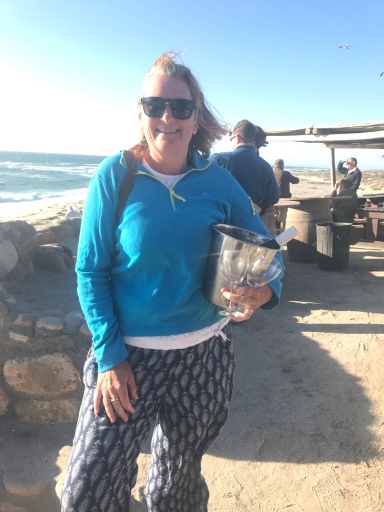


Next stop Stellenbosch…. But where to camp?, last time we were here we used a large campsite just outside town, but it wasn’t a great experience, so we thought we would try something a little smaller this time, and hopefully be able to walk to some the many wine tasting and eating venues that the place is famous for. Having the Daf really is a disadvantage in a place like this and especially at a time approaching the busy holiday season. The vast majority of wineries don’t have camping, and wine tasting when one of you is driving really isn’t a lot of fun (especially as it me that does the driving ha).
Orangeville Guesthouse proved the perfect location, access was extremely tight, and we had to drive across their nice lawns to get to the very small camp area. This was unlike any campsite that we had been on before, but it was no worse for that! With rose bushes (in full bloom) in front of us, and parked on an immaculate lawn, it was strange setting for a campsite. There was only one toilet and shower (enclosed together in a bamboo surround), but that was fine because it really isn’t for large groups.
The great thing about Orangeville is the location, it is at the bottom of a hill (about 15km from Stellenbosch), and from here there is a set route taking in the various local wine tasting places, ON FOOT if you want…..

We walked all the way to the very posh Tokara wine tasting room, this was about a 1.5 hours walk, in quite hot conditions, but we had a great experience in stunning surroundings.



Walking around this vast estate you come across some amazing sculptures that are completely out of place, but at the same in the perfect place.



We had lunch in the Tokara Delicatessen, which was a cheaper option than the main restaurant, had a fantastic meal for very little money, then had the much easier walk back down to Orangeville Guesthouse……, stopping only once at another winery for a quick drink.
We are nearing the end of our travels (after nearly 3 years in Africa), and it was here we met a German couple just setting out on their adventure in their converted Toyota Hilux. They were starting their trip in southern Africa, having shipped from Germany to Namibia, but Tim and Sarah’s trip has got a little twist, a certain little lady called Elizabeth. Yes they are travelling up the east side of Africa with a nine month old baby in a Hilux, now thats hard core.
But we got on so well with this couple from Germany that we decided to stay a few more days. We even used Uber for the first time, getting a car for all five of us and taking us into Stellenbosh for a Saturday market, here we sampled a few locally brewed beers, had a bite of lunch and got Tim a catapult.
Now obviously the catapult was purchased purely to keep the Baboons and Vervet Monkeys away later in their trip, and WAS NOT bought for horsing around and competing against the” hotshot” english guy camped next to him, oh no….


If truth be told we were both pretty crap at hitting the huge target set on the fence 20m away, but Tim’s catapult quickly became Elizabeths favourite toy, by the time she’s a year old I’m convinced she’ll be a better shot that both of us.

We had a great few days with this family, but sadly we had to leave,they were staying to help manage the German owned guesthouse over christmas and new year.We were booked into DeHoop Nature Reserve over Christmas,it was sad to say goodbye especially as we thought we would never see them again and I guess some people you just hit it off with, this was just such a situation.
Well we did meet them again, but I will write about that next time, sorry we are a little behind with lorrywaydown but I will write and post about our christmas and new year quite soon.
Thanks for reading and may we both wish you all the best for 2018, its going to be a strange one for us.
V